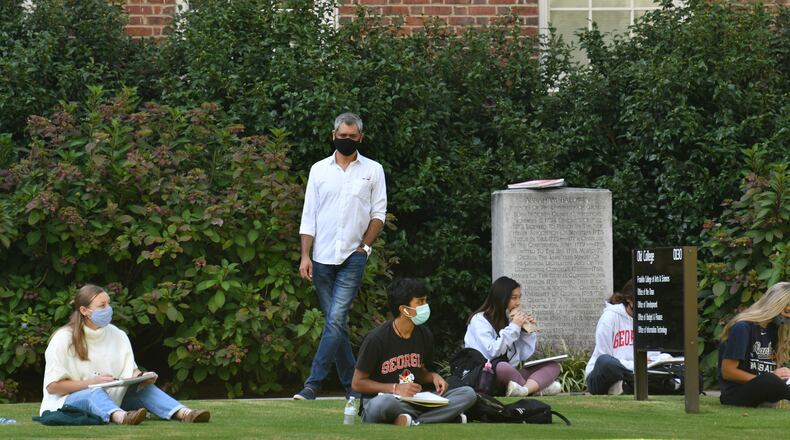Georgia is finally out of the COVID-19 red zone.
Citing decreasing cases and a lower test positivity rate, President Donald Trump’s coronavirus task force moved Georgia out of its most severe category in its latest report dated Sunday.
Georgia reported the 23rd highest rate of case growth in the United States from Sept. 19 to Sept. 25, according to the White House Coronavirus Task Force. It’s a marked improvement from mid-August, when Georgia reported the highest rate of new cases in the nation.
Georgia’s improved ranking is also a function of worsening epidemics in parts of the Midwest, South and West.
“When we are moving in the right direction, it does not mean we’re out of the woods,” said Dr. Sarita Shah, a physician and associate professor of global health, epidemiology and infectious diseases at Emory University’s Rollins School of Public Health.
The White House report makes several recommendations to tamp down spread at colleges, some of which have seen significant spikes since the start of the fall semester.
State officials continue to urge residents to follow “Four Things for Fall,” which includes wearing face coverings, practicing social distancing, washing hands and following public health guidance and that of Gov. Brian Kemp’s executive orders.
Georgia reported 92 new cases of the coronavirus per 100,000 people in the week ended Friday, one case below the national average for that period. It was the first time Georgia reported a new case rate below the national average since June, according to a review of task force reports published online by the investigative journalism nonprofit Center for Public Integrity.
In the orange zone
Georgia is now considered to be in the White House task force’s second-most severe zone for new cases, the orange of four-color coded ranges, while the state is in the third, or the yellow zone, for test positivity. Most of the major metro areas including Atlanta, Savannah and Columbus are in the yellow zone for new cases.
Cody Hall, a spokesman for Gov. Brian Kemp, described the improving outlook as validation of the governor’s “measured, data-driven approach” to the virus.
“Significant decreases in new cases reported, positivity rate, and current hospitalizations show that Georgians have continued to follow public health guidance and be part of the solution — not the problem,” Hall said.
But not all the news from the report is positive. The rate of newly reported deaths in Georgia remained above the national average last week, the report said.
The percentage of skilled nursing facilities and long-term care homes with at least one new infection and new deaths also is above the national average.
Since mid-July, Georgia has reported declining cases in nine out of the past 10 weeks, an Atlanta Journal-Constitution analysis of state data shows.
The current seven-day rolling average of new cases of 1,135 is down about 70% from the July peak, an AJC analysis of state data found.
On Monday, the Georgia Department of Public Health (DPH) reported 596 net new cases and 15 net new deaths. To date, Georgia has reported 315,281 confirmed cases of the coronavirus and 6,961 deaths attributed to COVID-19.
The number of people currently hospitalized stood at 1,319 on Monday.
Though cases and the number of people hospitalized for the virus have improved from their respective peaks, both figures remain well above their troughs.
The rolling average of new cases is nearly double the reported rate of May 31, while the rolling average of people hospitalized is nearly 70% higher than the bottom in early June.
Focus on colleges, flu season
The latest White House report continues to focus on outbreaks in college towns and reducing spread within long-term care facilities, which can be particularly deadly.
Though cases among young people tend to be less severe, health experts fear the virus can quickly spread to older and more vulnerable populations in the surrounding community, including residents of nursing homes.
In recent weeks, Athens, Statesboro and Dahlonega — home to the University of Georgia, Georgia Southern and the University of North Georgia, respectively — have scrambled to tamp down surges in the virus.
“Georgia is making progress and to sustain the gains, must continue the strong mitigation efforts statewide and continue mitigation efforts in university towns to decrease spread from universities to the local community,” Sunday’s White House report said. “Mitigation efforts must continue including mask wearing, physical distancing, hand hygiene, and avoiding crowds.”
Athens and Statesboro reported some of the highest rates of spread per capita in the nation after the opening of in-person instruction, before conditions started to improve in the past couple weeks.
“Ensure universities and colleges continue both rapid testing and contact tracing of symptomatic students and ... the rapid isolation of cases and quarantine of contacts,” the report said. “Residential cases and contacts should not be sent home to isolate or quarantine unless necessary.”
On Monday, Kemp announced the federal government plans to send 3 million rapid tests to Georgia in the next three to four months, with an initial allotment of 200,000. The White House report said the federal government also recently provided rapid antigen testing systems to Historically Black Colleges and Universities in the state.
The White House also urged the state to increase testing capacity and the budget of the state’s public health labs.
The report also recommends testing sewage in campus housing as an early warning surveillance system for the virus. Such detection has proven successful at other colleges, including the University of Arizona and Utah State. UGA recently developed a way to track the coronavirus in wastewater in Athens-Clarke County.
Unlike some previous White House reports, Sunday’s report does not call for a mask mandate. It does, however, urge Georgians to limit gatherings to 20 or fewer people, well below Kemp’s executive order, which caps gatherings at 50 people.
As cooler fall weather approaches, the risk of contracting the coronavirus is expected rise and officials also urge residents to get a flu shot to help prevent co-infection of COVID-19 and influenza.
“We don’t want to overburden the health care system with people suffering from complications of the flu that could be prevented or lessened by getting a flu shot, especially when hospitals are still treating hundreds of COVID-19 patients,” Department of Public Health spokeswoman Nancy Nydam said.
About the Author
Keep Reading
The Latest
Featured



